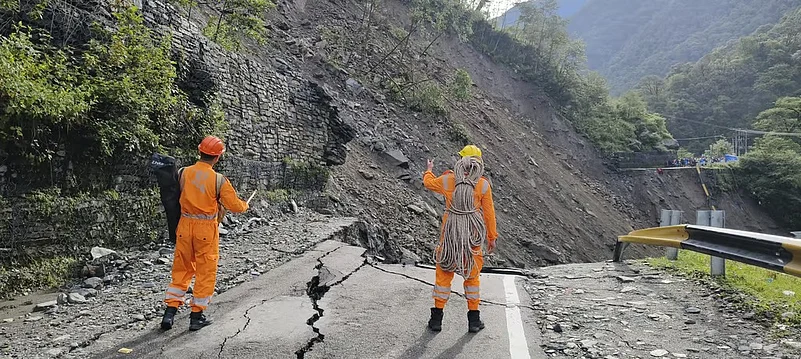Uttarakhand, a Himalayan state, has been witnessing an alarming increase in landslides this monsoon. Experts like Dr. Sunil Nautiyal, Director of the GB Pant National Himalayan Environment Institute, point to significant changes in the region's rainfall patterns as a key cause for this. These changes, he says, are linked to climate change and the fragile ecology of the region.
This year's monsoon has been particularly illustrative of this shift. Nautiyal notes, “This year widespread rain has occurred only between September 13 and 15, otherwise it remained at local levels throughout the monsoon.” Normally, the region experiences long periods of rain during the monsoon season, primarily in June and July, but this year, heavy rain has been delayed until mid-September. This irregularity is deeply concerning because sudden, intense rainfall on already saturated or fragile soil significantly increases the likelihood of landslides.
The Shift in Rainfall Patterns
In the past, Uttarakhand's monsoon followed a more predictable pattern, with consistent rainfall spread over several months. However, as Dr. Nautiyal highlights, the region is now seeing a shift where sudden bursts of intense rainfall occur after prolonged dry spells. This shift is attributed to climate change, which is disrupting established weather patterns worldwide.
The Himalayan region is especially vulnerable to these changes due to its unique geography. The mountains are composed of relatively young and fragile rock formations, which are highly susceptible to erosion. When heavy rains occur suddenly after long dry periods, the soil does not have time to absorb the water, leading to landslides.
The India Meteorological Department (IMD) confirms this year's abnormal rainfall, reporting an average of 102 mm of rain across three days in mid-September. The sudden influx of rain on already unstable terrain is a recipe for disaster, leading to a rise in landslides across the state.
The Role of Forest Fires
In addition to irregular rainfall, another major factor contributing to landslides is forest fires. According to Dr. Nautiyal, forest fires in the region have exacerbated soil erosion. “Forest fires burn herbs and grasses, which weakens the soil layer and fails to stop the flow of water. This leads to landslides,” he explains. When vegetation is burned, the natural barrier that would typically slow down rainwater is destroyed, allowing water to flow freely and erode the soil. Over time, this can destabilize the landscape and make it more prone to landslides when heavy rain finally arrives.
Decreasing Agricultural Activity and Ecological Health
Agriculture in the Himalayan region has also been negatively affected by the changing weather patterns. Local farmers have increasingly abandoned agriculture due to crop damage caused by irregular rains, erratic temperatures, and landslides. As agricultural activity declines, the protective cover provided by crops diminishes, further weakening the soil and increasing its susceptibility to erosion.
Dr. Nautiyal stresses the importance of studying these weather-related impacts on Himalayan agriculture and calls for a collective effort among multiple agencies to better understand and mitigate the damage. The GB Pant Institute is actively conducting research on these issues, but as Nautiyal points out, “Efforts being made by only one institute in this direction will not be enough.”
Preserving the Local Ecology

Despite these challenges, there are success stories where the local ecology remains intact and plays a crucial role in maintaining the region's environmental balance. Nautiyal mentions Jaddhar forest in the Garhwal region and Shitalakhet forest in Kumaon as examples of how dense forests can help stabilize the local ecosystem. These areas, he says, have been able to sustain early and heavy monsoon rains due to their healthy forest cover, which helps retain water and prevent soil erosion.
Local participation and governance have been essential in preserving these areas, showcasing the power of community-driven ecological conservation. The National Mission for Sustainable Himalayan Ecosystem, one of the Government of India's key initiatives, is also working towards restoring the ecological health of the region. By promoting sustainable practices and working closely with local communities, the mission aims to strengthen the region’s ability to withstand the effects of climate change.
The Path Forward
The rise in landslides in Uttarakhand is a clear signal of the urgent need to address climate change and its impact on vulnerable ecosystems. Dr. Nautiyal’s insights underline the importance of multidisciplinary research and collaborative efforts to tackle the complex challenges faced by the Himalayan region. Local governance, sustainable practices, and targeted scientific studies are critical in preserving Uttarakhand's ecological balance and ensuring the safety and livelihood of its residents.
As climate change continues to alter weather patterns, Uttarakhand must prioritize the resilience of its fragile landscape. Proper planning, better forest management, and improved early warning systems can go a long way in mitigating the destructive effects of irregular rainfall and landslides. By working together, governments, scientific institutions, and local communities can help safeguard the region’s future against the growing threat of climate-induced disasters.
In the meantime, as Dr. Nautiyal wisely notes, “We must study the adverse effects of weather on Himalayan agriculture and soil stability more deeply.” The solutions may lie not just in modern technology, but in ancient practices of land stewardship and forest conservation.

















